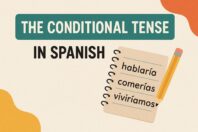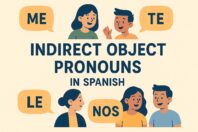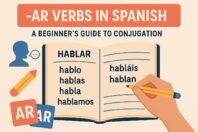Infinitives in Spanish: How to recognize and use the Spanish infinitive verb form

Get our free email course, Shortcut to Conversational.
Have conversations faster, understand people when they speak fast, and other tested tips to learn faster.
More infoInfinitives in Spanish are the unconjugated forms of verbs.
In this post we’ll learn to easily recognize the different Spanish infinitives, and we’ll learn how and when to use them in sentences.
Now let’s dive in and begin our lesson on infinitives in Spanish!
What Are Infinitives in Spanish?
The infinitive is the basic form of the verb that we see in dictionaries, whether in Spanish, English, or another language.
The infinitive is the basic verb form, before conjugating for any specific subject or tense. As such, an infinitive refers to an action itself, but doesn’t tell us anything about the time or the person doing or receiving the action.
We start with an infinitive and then conjugate it to provide the information of who and when. The infinitive is therefore best known as the base form before conjugation. We’ll get into the three groups of unconjugated Spanish infinitives in the next section.
Infinitive verbs can also be used in numerous contexts in their infinitive forms, whether in combination with other conjugated verbs or on their own. We’ll introduce the most common ways to use infinitive verbs in Spanish sentences once we’ve finished going over the three conjugation groups.
How to recognize infinitives in Spanish
Infinitives are easy to recognize in both English and Spanish. The key difference between infinitives in Spanish and English is that English infinitives are made up of two words, always starting with to, whereas Spanish infinitives are a single word, almost always ending with one of three infinitive endings.
Examples of English infinitives are to love, to run, and to leave, while these same infinitive Spanish examples are amar, correr, and partir.
Spanish infinitives are recognized by their endings. Grammatically, we differentiate between verb groups based on the three infinitive endings: -ar, -er, and -ir verbs. In Spanish, we refer to these three groups as the first, second, and third conjugation, or primera, secunda, and tercera conjugación in Spanish.
In addition, there’s an additional category known as reflexive verbs, whose infinitive forms have an -se added onto the original infinitive form from the three standard groups.
To demonstrate the three categories of infinitive verbs in Spanish, as well as the reflexive infinitives, we’ll present a list of Spanish verbs for each one in the next sections.
First conjugation verbs: Infinitives ending in -ar
Spanish infinitives in the primero conjugación group are easily recognized as -ar verbs.
| Infinitives: Spanish -ar verbs | Infinitives: English |
| Abrazar | To hug |
| Acordar | To agree |
| Actuar | To act |
| Aterrizar | To land |
| Bailar | To dance |
| Besar | To kiss |
| Buscar | To search, To look for |
| Cancelar | To cancel |
| Cerrar | To close |
| Donar | To donate |
| Enfermar | To get sick |
| Escuchar | To listen |
| Hablar | To speak, To talk |
| Jugar | To play |
| Olvidar | To forget |
| Soñar | To dream |
- Su madre no quiso hablar con la maestra. – His mother didn’t want to talk to the teacher.
- Caminar todos los días es un hábito saludable. – Walking every day is a healthy habit.
- Nadie puede hablar en esta sala. – No one may speak in this room.
- Tuvimos que cancelar la reunión de esta mañana. – We had to cancel the meeting this morning.
For more -ar verbs, including their regular and irregular conjugations, have a look at our post with the 44 most important -ar verbs in Spanish.
Second conjugation verbs: Infinitives ending in -er
Here’s our next list of infinitives in Spanish, of -er verbs in the second conjugation group:
| Infinitives: Spanish -er verbs | Infinitives: English |
| Aprender | To learn |
| Beber | To drink |
| Caer | To fall |
| Conocer | To know, To meet |
| Entender | To understand |
| Barrer | To sweep |
| Esconder | To hide |
| Leer | To read |
| Nacer | To be born |
| Perder | To lose |
| Querer | To want |
| Obedecer | To obey |
| Saber | To know |
| Ser | To be |
| Volver | To come back |
| Vender | To sell |
- Pedro no quiere vender su coche. – Pedro doesn’t want to sell his car.
- Paula tiene que obedecer las reglas. – Paula has to obey the rules.
- No vamos a volver mañana. – We are not going to come back tomorrow.
- No pudieron entender lo que estaba sucediendo. – They couldn’t understand what was happening.
We’ll also recommend our other post with 27 Spanish -er verbs that every beginner student should know, which also covers their conjugation.
Third conjugation verbs: Infinitives ending in -ir
The third conjugation group consists of the infinitive verbs in Spanish with -ir endings:
| Infinitives: Spanish -ir verbs | Infinitives: English |
| Abrir | To open |
| Conducir | To drive |
| Construir | To build |
| Corregir | To correct |
| Escribir | To write |
| Discutir | To discuss |
| Huir | To run away, To flee |
| Imprimir | To print |
| Ir | To go |
| Medir | To measure |
| Oír | To hear |
| Prohibir | To ban, To prohibit |
| Reír | To laugh |
| Salir | To go out |
| Vivir | To live |
| Sonreír | To smile |
- No sé si vamos a salir esta noche. – I don’t know if we are going to go out tonight.
- Teníamos que vivir una aventura así en Argentina. – We had to live through an adventure like that in Argentina.
- Fue entonces, cuando se empezó a prohibir el alcohol por las noches. – It was then, when alcohol started to be forbidden at night.
- No queríamos huir, pero no teníamos otra chance. – We didn’t want to run away, but we didn’t have a chance.
For more third conjugation verbs, including conjugation rules, check out our dedicated post with the 30 most-common -ir verbs in Spanish.
Reflexive verb infinitives: -ar, -er and -ir endings +se
Reflexive verbs in Spanish are used when the subject of a sentence carries out an action on themself. The infinitive always has the reflexive pronoun se attached to the end, equivalent to the English onself.
If we start with a verb like bañar, meaning to bathe, for example, it becomes bañarse for to bathe oneself. If we talk about a mother bathing her child, we don’t use the reflexive, whereas when she bathes herself we use the reflexive bañarse.
Reflexives are much more common in Spanish than in English, extending beyond simple actions that we do to ourselves. Check out our guide to reflexive verbs in Spanish for a full explanation.
As for reflexive infinitives in Spanish, we just start with the standard -ar, -er, or -ir infinitives that we’ve seen so far, and append the -se at the end. Here are some examples for each conjugation group:
| Infinitives: Reflexive -ar verbs | Infinitives: English |
| Sentarse | To sit down |
| Acostarse | To lie down |
| Peinarse | To comb [one’s hair] |
| Levantarse | To get up |
| Afeitarse | To shave [oneself] |
| Infinitives: Reflexive -er verbs | Infinitives: English |
| Meterse | To get [oneself] into, To get mixed up with |
| Esconderse | To hide [oneself] |
| Perderse | To become lost, To get lost |
| Ponerse | To put on |
| Volverse | To become |
| Infinitives: Reflexive -ir verbs | Infinitives: English |
| Vestirse | To get dressed, To dress oneself |
| Dormirse | To fall asleep |
| Irse | To leave, To take one’s leave |
| Morirse | To die |
| Sentirse | To feel |
- Lara intentó peinarse pero no pudo. – Lara tried to comb her hair but she couldn’t.
- Mateo no pudo ponerse el sombrero en la iglesia. – Mateo couldn’t put on his hat in the church.
- Los profesores aceptaron irse temprano. – The teachers accepted to take their leave early.
- Los niños tenían que dormirse a las 9 p.m. – The kids had to go to sleep at 9pm.
When to use infinitives in Spanish
Although verbs are usually conjugated when used in spoken or written Spanish, there are indeed various circumstances where we can use the infinitive verb form in a sentence.
In the following sections, we’ll go over various contexts where we can use the infinitives in Spanish. Note that while the English translations sometimes also use the infinitive form, other English verb forms are often a better fit.
After certain conjugated verbs
Many verbs can be followed directly by another verb when the first’s action affects the second. In these cases, the first verb is conjugated, while the second remains in the infinitive form. Sometimes a preposition is necessary between the two, depending on the verb or the context.
Here are some of the most common verbs that can be followed by another infinitive verb in Spanish. We’ve included links to our other posts that go into more detail on a few of them.
| Spanish verbs | English verbs |
| Querer | To want |
| Preferir | To prefer |
| Gustar | To like |
| Odiar | To hate |
| Prometer | To promise |
| Recordar de | To remember to |
| Intentar | To try to |
| Aceptar | To accept to |
| Poder | To be able to |
| Empezar | To start |
| Necesitar | To need to |
Let’s see some of these verbs in action:
- ¿Te acordaste cerrar la puerta antes de irte? – Did you remember to close the door before you left.
- Prefiero ir al cine antes que al teatro. – I prefer to go to the cinema over going to the theater.
- Tenemos que hacer la cama todos los días. – We have to make the bed every day.
- Me gusta comer helado de chocolate. – I like eating chocolate ice cream.
In the immedate past or future
Spanish has some easy hacks for talking about the past and future without needing to learn any specific past or future tenses. In these constructions, we just conjugate the first verb, we add the preposition, and then include the infinitive form of the verb whose action just occurred or will soon occur.
For the immediate past, we can use either venir de + infinitive or acabar de + infinitive. In either case, the English translation usually begins with the word just. Let’s see how this works with a few examples:
- Vengo de llamar a mis abuelos. – I just called my grandparents.
- Venían de llegar cuando los llamé. – They had just arrived when I called them.
- Acabo de organizar las herramientas. – I just organized the tools.
- Nuestro jefe acaba de asignar al equipo un nuevo proyecto. – Our boss just assigned the team a new project.
For the immediate future, we use ir a + infinitive the same way. The English translation is generally along the lines of going to + infinitive. Let’s see this in a few examples.
- Isabel va a cocinar para todos nosotros hoy. – Isabel is going to cook for all of us today.
- Mis padres van a proporcionar los ingredientes. – My parents are going to provide the ingredients.
- ¡El viernes por la noche, vamos a bailar hasta el amanecer! – On Friday night we’re gonna dance ’til dawn!
- El sábado, voy a dormir hasta el mediodía. – On Saturday, I’m going to sleep in until noon.
For full lessons on these constructions, check out our detailed posts on talking about the past using acabar de and on talking about the future using ir a.
When expressing obligations with tener que or hay que
In Spanish we have two common constructions to express obligation: tener que + infinitive and hay que + infinitive.
With the tener que construction, we first conjugate the verb tener to match the subject, so the English translation often begins with must or needs to. With hay que there’s intentionally no subject, conveying a sense of general obligation rather than necessarily pointing a finger at whose obligation it is. The English equivalent is often in the passive voice. For a deeper look at these two expressions, check out our post on using hay que vs tener que for expressing obligation in Spanish.
In both cases, the action that’s obligatory is expressed using the Spanish infinitive.
- Tenemos que estudiar para aprobar el examen. – We have to study to pass the exam.
- Los dueños tienen que limpiar la suciedad de sus mascotas. – Pet owners have to clean up after their pets.
- Hay que lavar los platos todos los días. – Dishes must be washed every day.
- Todos los meses, hay que pagar las cuentas de la casa. – Every month the bills of the house have to be paid.
When giving impersonal commands
In Spanish it is very common to find infinitives used to give general commands, whether in recipes or in instructions or on signs. This use is distinct from the imperative conjugation, in which a command is directed at someone specific.
- No fumar. – No smoking.
- Batir el queso crema hasta que esté suave. – Beat the cream cheese until it’s smooth.
- Conectar el cable rojo con el negro. – Connect the red wire to the black one.
- No correr por los pasillos. – Don’t run in the hallways.
For specifics on the imperative mood check out or post informal commands in Spanish.
When using verbs to name activities
In this use, the Spanish infinitive effectively functions as a noun. Infinitives used as nouns are considered masculine and singular. The English translation is usually a gerund: the -ing verb form.
- Fumar es malo para tu salud. – Smoking is bad for your health.
- Correr tres millas al día es genial. – Running three miles per day is awesome.
- Leer de niño es beneficioso para el futuro. – Reading as a kid is beneficial for the future.
Conclusion
To sum up our lesson here, we’ve seen that infinitives in Spanish refer to the unconjugated verb form.
We learned that the Spanish infinitives are grouped according to their endings, being easily recognized as -ar verbs, -er verbs, and -ir verbs. We also covered reflexive infinitives in Spanish, which come in the same three groupings but have an additional -se ending. We provided a list of Spanish infinitives for each of these verb groups.
We then spent some time going over the most common scenarios where we use the infinitive verb form in written and spoken Spanish, with plenty of examples for each one.
The focus of this post was indeed on infinitives in Spanish, with an emphasis on when they can be used in their infinitive form. Nonetheless, the most important role of the infinitive is as the basic verb form before conjugation. With a good grasp of the infinitive form, we encourage you to explore all the Spanish verb tenses that are all built from the infinitive.
Spanish infinitives practice
¡Vamos a trabajar! – Let’s get to work! We’ll wrap up our post with a few practice exercises. Based on what you’ve learned in this post, translate the following sentences using the infinitives in Spanish:
1. We didn’t want to take the train to Paris.
2. No chatting in this room.
3. Whisk the sugar and the eggs.
4. Eating vegetables is the best for your health.
5. She tried to open the door but she couldn’t.
6. Someone has to come to class today.
7. Ciro hates getting up early on Sundays.
Answers
1. No quisimos tomar el tren a París.
2. No hablar en esta sala.
3. Batir el azúcar y los huevos.
4. Comer vegetales es lo mejor para tu salud.
5. Ella intentó abrir la puerta pero no pudo.
6. Alguien tiene que venir a clase hoy.
7. Ciro odia levantarse temprano los domingos.


